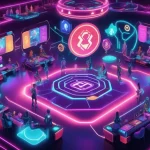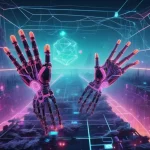Blockchain Gaming at Tokyo Game Show 2025: Still Experimental, But Showing Promise

Tokyo Game Show 2025: Blockchain Gaming Lingers in the Experimental Shadows
At Tokyo Game Show 2025 (TGS2025), one of the planet’s premier gaming expos, dazzling VR setups and blockbuster titles command the spotlight. Yet, tucked away from the roaring crowds, a quiet blockchain revolution simmers in the shadows. Could this oft-maligned tech, battered by past failures, finally find its footing in gaming? Let’s unpack the niche but persistent presence of blockchain at this year’s event.
- Subtle Presence: Blockchain tech barely registers at TGS2025, overshadowed by mainstream gaming giants.
- OrdinalX Breakthrough: A BSV-based NFT API service aims to make blockchain integration painless for developers.
- Experimental Limbo: Despite scalability wins, blockchain gaming struggles to prove its worth to Big Gaming and skeptical players.
Setting the Scene: A Niche Corner at TGS2025
Walking through the sprawling halls of TGS2025, the sheer scale of digital entertainment on display is staggering. Corporate heavyweights like PayPal (NASDAQ: PYPL) and AAA game publishers dominate with glitzy booths and immersive demos. Amid the sensory overload, blockchain technology feels like a wallflower at the party. Its presence is confined to quieter corners, most notably the BSV Blockchain Japan booth in the Business Solutions section, sponsored by the BSV Association. Here, a small but dedicated group showcases what could be the future of gaming economies—if only the industry would take notice. For those new to the term, BSV (Bitcoin Satoshi Vision) is a fork of Bitcoin from 2018, designed to prioritize scalability and ultra-low transaction fees, staying closer to Satoshi Nakamoto’s original vision of peer-to-peer cash compared to many altcoins drowning in complex DeFi experiments.
BSV and OrdinalX: A Scalability Game-Changer?
At the heart of blockchain’s quiet push at TGS2025 is OrdinalX, an NFT API service developed by YenPoint, a Japanese company led by CEO Ken Sato, who also serves as a BSV Association Ambassador for Japan. OrdinalX aims to strip away the daunting complexity of blockchain integration, offering developers a plug-and-play solution to embed NFTs (non-fungible tokens) and BSV wallets into games, apps, or websites. NFTs, for the unfamiliar, are unique digital assets recorded on a blockchain, often representing ownership of virtual goods like in-game skins, weapons, or rare collectibles. What sets OrdinalX apart is its use of 1Sat Ordinals—think of it as tagging a unique identifier on the tiniest unit of Bitcoin, a single satoshi, much like a serial number on a penny. This keeps transaction costs negligible, often less than a cent, compared to fees of $5 or more on networks like Ethereum during peak times.
BSV itself boasts impressive specs, claiming to handle over 50,000 transactions per second, dwarfing Ethereum’s current 15-30 TPS. This scalability, paired with sub-cent fees, makes it a compelling option for gaming, where microtransactions—say, trading a virtual sword—need to be fast and cheap to feel seamless. Sato emphasizes the simplicity OrdinalX brings to the table, handling the technical headaches so developers can focus on creating.
“OrdinalX is basically an NFT API service, based on the BSV blockchain and 1Sat Ordinals technology. What it does is help you implement NFTs into an app, web page, or into a game easily. It basically does the wallet part. It’s wallet infrastructure,”
Sato explains, cutting through the jargon with a clarity that hints at untapped potential.
Indie Innovators: Crafters Wild as a Test Case
While OrdinalX lowers the technical barriers, it’s indie creators who are truly testing whether blockchain can redefine gaming. A prime example at TGS2025 is Crafters Wild, an open-world adventure and survival game developed by a local talent known as Gandalf. Set for public beta testing soon, the game leverages OrdinalX to tokenize in-game items as 1Sat Ordinals, enabling players to trade them on a dedicated marketplace. Picture this: you craft a rare axe after hours of grinding, then sell it to another player for real value, all secured by blockchain with fees so low they’re barely noticeable. It’s a glimpse into a future where player-driven economies could rival real-world markets.
“I like BSV, and I wanted to build something that uses BSV, so I built the game. It’s a system that will change the world, I wanted to be the first person to use it like this so I could teach other people how to do it too,”
Gandalf shares, embodying the trailblazing grit that defines indie developers in the blockchain gaming space.
For indie devs, tools like OrdinalX are a godsend. Without the deep pockets of AAA publishers, they can afford to experiment with blockchain integrations, testing concepts that could eventually trickle up to bigger players. This grassroots innovation is where blockchain gaming trends in 2025 are taking shape, far from the polished boardrooms of corporate gaming giants.
Why Blockchain Gaming Keeps Stumbling
Let’s not kid ourselves—blockchain gaming has a rap sheet longer than a CVS receipt. Rewind to the 2021-2022 hype, and “play-to-earn” models like Axie Infinity promised players real income through NFTs. The reality? Many collapsed under Ponzi-like economics, where new players funded payouts for early adopters, leaving latecomers holding worthless tokens. Networks like Ethereum and Polygon became punching bags for failure, with gas fees hitting tens of dollars just to move a lousy NFT or record a few kilobytes of data. Network congestion turned trades into agonizing slogs, and regulatory heat didn’t help—governments worldwide tied blockchain gaming to speculative scams and shady tokenomics, casting a long shadow of distrust.
“Even putting just a few kilobytes of data, you have to pay tens of dollars; just moving an NFT costs a lot of money. So why would you use it for a game? How is that technology adding extra value to the games?”
Sato’s pointed critique nails why blockchain tanked spectacularly in gaming’s early experiments.
Beyond cost, user experience remains a mess. Onboarding players to crypto wallets or explaining NFTs often feels like teaching quantum physics to a toddler. Security risks loom large too—hacks of NFT marketplaces have burned trust, and even on scalable chains like BSV, centralization creeps in. If a game’s marketplace or token issuance is controlled by a single entity, it undermines the decentralized ethos blockchain stands for. Then there’s the regulatory maze: while Japan maintains a relatively crypto-friendly stance, regions like the EU, with frameworks like MiCA, might classify in-game NFTs as financial instruments, creating legal nightmares for developers. These hurdles keep blockchain gaming in a frustrating limbo.
Big Gaming and Gamers: A Wall of Skepticism
Corporate gaming giants, the billion-dollar franchises behind polished titles, view blockchain like a radioactive hot potato—too risky to touch, even if it might cook up the next big idea. The stigma from past flops, coupled with the massive cost of overhauling existing systems, keeps it off their radar. Why gamble on unproven tech when microtransactions through proprietary platforms already rake in cash? At TGS2025, blockchain’s minimal footprint on the main floor speaks volumes about Big Gaming’s cold shoulder, as highlighted in reports from the event like those covering blockchain’s experimental status in gaming.
Gamers themselves aren’t exactly rolling out the welcome mat either. Many at the expo seem wary, some muttering about “just another cash grab” when asked about NFTs in video games. The distrust from overhyped, underdelivered projects lingers like a bad hangover. Yet, there’s a demographic wildcard: younger generations, especially Gen Z and millennials raised on digital ownership, often overlap as gamers and NFT traders. As they step into developer roles or even executive suites over the next decade, attitudes might shift. The notion of trading a rare in-game item across different platforms, as seamless as a Venmo transfer, could become a rallying cry—if the tech proves itself.
The Road Ahead: Hype vs. Hard Proof
Blockchain gaming at TGS2025 feels like a scrappy underdog, brimming with potential but lacking the knockout punch to win over the masses. Tools like OrdinalX and projects such as Crafters Wild are laying critical groundwork, proving that low-cost, scalable solutions on BSV can work where others failed. Sato remains cautiously optimistic, noting the experimental nature of it all but betting on adoption as ease-of-use spreads.
“It’s all still in the beginning stages and still experimental, but once developers see how easy it is, more will want to try it,”
he remarks, grounding hope in practicality.
Still, a word of caution: while innovations shine, the ghosts of scams past haunt this space. Gamers and devs alike should beware of projects hyping instant riches—history shows most are frauds preying on FOMO. If blockchain gaming is to rise, it won’t be on empty promises but on tangible value. Could we be on the cusp of a player-owned future, where digital assets are as tradable as physical goods? Only if the industry cuts through its own baggage and delivers hard proof over hollow hype.
Blockchain Gaming at TGS2025: Top 5 Questions Answered
- How is blockchain gaming faring at Tokyo Game Show 2025?
It’s a faint whisper amid mainstream gaming noise, limited to niche exhibits like the BSV Japan booth, signaling it’s far from widespread acceptance. - What makes OrdinalX a potential game-changer for BSV blockchain gaming?
It simplifies NFT and wallet integration with a user-friendly API, slashing costs and complexity so developers can experiment without breaking the bank. - Why has blockchain struggled in gaming historically?
Crippling fees, network bottlenecks on chains like Ethereum, and regulatory backlash from shady “play-to-earn” schemes have trashed its reputation. - Is there a future for NFTs in video games?
Possibly, if scalable solutions like BSV catch on and younger, NFT-familiar generations push for cross-platform ownership, though skepticism remains high. - Who’s driving blockchain gaming trends in 2025?
Indie developers and experimental projects like Crafters Wild lead the charge, using affordable tools to test ideas corporate giants won’t touch.



